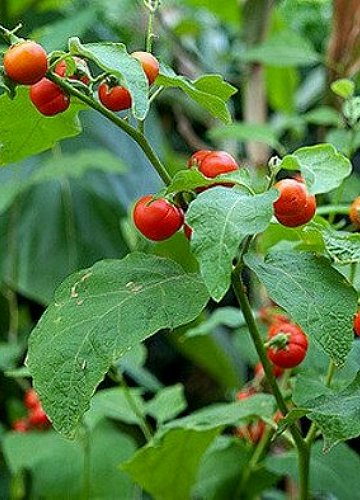
|
|
Cannibals Tomato
(Solanum viride).
|
Cannibals Tomato - Solanum viride
Solanum viride ( S. uporo, S. anthropophagorum)
belongs to t he family of the Solanaceae, the nightshades. It is an erect
(but sometimes subscandent or sprawling) shrub growing 1-3 metres tall. A form that has arisen out of cultivation
(cv. 'Anthropophagorum') is sometimes grown for its edible leaves and fruits. It is native to
Fiji, Tonga, Samoa, the Tuamotus and as far west as Hawai. It is also known as cannibal tomato or poro
poro. This ghoulish nickname is due to the fact that one says that human meat gets better digested when one eats a sauce made of S. uporo with the
meat.
S. uporo is an herbaceous, perennial plant that reaches a height form 1 to 1, 5 m.
The flowers are white, the corolla has 5 petals and the stamens are brightly
yellow. The flowers stand in inflorescences of up to 5 flowers. They resemble the flowers of the potato and other
Solanaceae. The fruits look just like the common tomato and are cooked just like
that. Eaten raw they have a very bitter taste. The fruits get 2 cm in diameter. The seeds lie in the
pulp.
The first collections of the species were created during the second research trip of James Cooks to New Zealand and into the South Pacific (1772-1775) by Johann Reinhold Forster and his son Georg
Forster. Since the name published in Georg Forster's dissertation De plantis esculentis insularum Oceaniae 1786 is not validly
published, the regular first description by the German botanist and physician Kurt Sprengel 1807 comes under the name given by the Forsters on the Herbarbelegen name Solanum
viride.
Later, the plant was described several times under another name, so in 1852 by the French botanist Michel Félix Dunal under the name Solanum
uporo, under which the plant is still often found today.
However, she received the name "Cannibals Tomato" in 1864 from Berthold
Seemann, which is also reflected in the scientific name Solanum anthropophagorum. He reported that he had learned from the inhabitants of
Fiji, who at that time were allegedly still occasionally "cannibalistic", that human flesh was difficult to
digest, but that it became more digestible when prepared with three different plant
species. These species are on the one hand, the Cannibals Tomato, on the other
hand, the leaves of Malawari (Trophis anthropophagorum) and Tudano (Homalanthus
pedicellatus). While Malawari and Tudano are wild-growing trees, the Cannibals Tomato
was cultivated, often near the huts called bure-ni-sa (stranger's house), where those killed in the war were
brought. According to Seaman, there was a superstition among the indigenous population that touching children with hands that had previously touched human flesh causes
disease. That's why the meat was only touched with long wooden forks.
Originally they wrapped the meat of slain enemies in the leaves and roasted on stones in the
fire, later they used the big pots they traded with the Beche-de-mer fishers to first cook the man
meat. They then served it with the greens and cooked fruit of the plant, basically like a tomato pasta
sauce.
Nowdays, there is no evidence that the wild form of this plant is used for
food, but a form with larger leaves and fruits (cv. 'Anthropophagorum') is traditionally cultivated in and near villages as a food
crop.
The fruits ares edible when cooked. They resemble
tomatoes, and are used for making sauces. Leaves and young stems are edible too - cooked as a
potherb.
The roots of S. uporo are poisonous. They include steroid
alkaloids.
Source:
https://de.wikipedia.org/wiki/Menschenfressertomate
https://www.asklepios-seeds.de/gb/solanum-uporo-seeds.html
http://tropical.theferns.info/viewtropical.php?id=Solanum+viride
